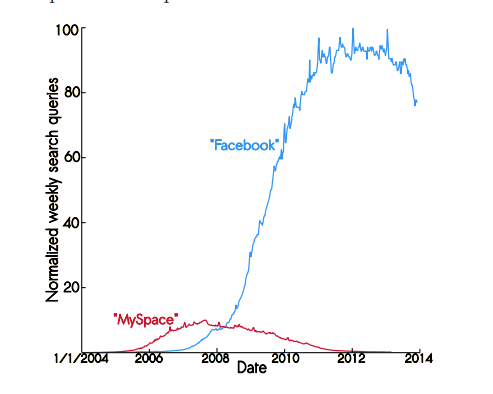Back in 2006, I created my first account on a social media website. Only a few of my friends had signed up on social media by then. I also thought that only a few people would be part of social media. Within a few years, what I witnessed was a boom in the social media industry. Now my whole family was on social media and I started to cringe because I was tagged every day on a Good Morning message by a random uncle with 50 others. 😛
Can you guess which social Media Company I am talking about!! The mighty Facebook
Facebook was started at a Harvard University Dorm room in 2004. In September 2006, Facebook became global and was open to everyone. The growth in rate of membership was crazy.
- 2006: 12 million
- 2007: 50 million
- 2012: 1 billion
- 2020: 2.2 billion
The journey is not that simple as it looks. But with the right kind of strategy adoption, Facebook became the powerhouse of social media.
Usually, when a company enters a market it has to deal with many external forces. It is very complex to decide which market the product/service should be launched. But one solution to this is the Beachhead strategy that explains to starts small and become the leader in that niche market before expanding.
What is a Beachhead Strategy?
The origin of Strategy dates back to 1944. It was originally a military strategy that was planned and led by Dwight D. Eisenhower. The strategy was used by allies in WWII. The beachhead market is named after the WWII battle of Normandy where Allied soldiers stormed the beachheads of Normandy enabling them to dominate one of the most important battles of WWII; without this win, the war may have ended in German victory. The idea here was to establish a beachhead and take just one beach and then they could expand their beachhead to conquer the other areas nearby.

This strategy slowly became popular and is now used in corporate and startup world.
Beachhead strategy in laymen terms is about identifying the smallest market for the product/service and then focus on winning that smallest market. Once this is done business can expand to adjacent markets. This strategy helps the business especially startups to compete in a market that has established players by solving a problem these established firms have not.
A beachhead market is a place where, once you gain a dominant market share, you will have the strength to attack adjacent markets with different opportunities, building a larger company with each new following
Bill Aulet, author of Disciplined Entrepreneurship: 24 Steps to a Successful Startup
How Facebook used the Beachhead strategy?
When Facebook started, Myspace was the leader in the social media space and Facebook had little to no chance of competing against that giant. But Facebook was confident of its new product, new technology, and had a clear idea of its target market.
Now comes the Beachhead Strategy that Facebook used here. Instead of competing directly with Myspace, Facebook established a beachhead elsewhere. Facebook initially provided access to Harvard university students/alumni only. Facebook focused all its strategy efforts and resource on securing one university. One campus at a time was the clear strategy here. It identified campuses where Myspace was not strong and established its Beachhead. But by the time Myspace could realize it was already dead.

Later Facebook made strategy and efforts in dominating the university market in other countries for the next few years before expanding globally to target the non-university population. It helped in the validation of ideas and having some cash flow.
Is Beachhead Strategy same as having a Niche?
Actually No!! Beachhead strategy and having a niche are two different things. Niche is a long term strategy while Beachhead strategy is a short term strategy. Niching is about focusing on one specific segment of the market whereas beachhead strategy is about dominating the whole selected market.
The beachhead strategy is used by organizations across the globe, especially by startups.
A great example is how Amazon initially focused on the books business which had a consistent demand and supply curve allowing an establishment of the Beachhead of revenue. Using the beachhead strategy then amazon expanded to adjacent product categories and then expanded to different markets eventually to become a leading E-commerce Company in the world.
Now let’s talk about the banking sector which is using payment as the beachhead. Payment related interactions represent more than 80 percent of customer interactions with banks, making payments a superb platform, or “beachhead,” for cross-selling other financial services.
Read: Did Zomato Leverage its First Mover Advantage in Food Tech?
Is Beachhead strategy that simple? What are the risks?
The beachhead strategy has its challenges. The market dynamics and the type of product/service play a key role in the strategy. The time that company is not expanding to other markets is an advantage for the competitor and lost revenue.
It is sometimes difficult to identify that smallest possible market that is big enough to be meaningful, yet small enough to win. Startups that establish a wrong beachhead increase the risk of failure due to limited revenue opportunities available.
Beachhead strategy is like a double-edged sword. It has advantages in giving an opportunity to enter the market with already established players. It also has disadvantages in limiting the drastic growth as the strategy is about focusing on one market at a time.
A business has to be cautious while implementing the beachhead strategy. When a company identifies a rapidly growing market well suited to its products and capabilities, it will often rush to gain a beachhead in it. In this excitement, it is easy to fall into the trap of neglecting other emerging players in the market. Neglecting competitors can be dangerous as they may also be looking to develop their own beachheads with their own newly developed technologies.
The beachhead strategy could also be used for the creation of a monopoly in some markets which would have a bad effect on end customer and innovation of the sector. But then that’s a story for another time!!
Interested in reading our Advanced Strategy Stories. Check out our collection.
Also check out our most loved stories below
-AMAZONPOLLY-ONLYWORDS-START-
Also, check out our most loved stories below

Why did Michelin, a tire company, decide to rate restaurants?
Is ‘Michelin Star’ by the same Michelin that sells tires, yes, it is! But Why? How a tire company evaluations became most coveted in the culinary industry?

Johnnie Walker – The legend that keeps walking!
Johnnie Walker is a 200 years old brand but it is still going strong with its marketing strategies and bold attitude to challenge the conventional norms.

Starbucks prices products on value not cost. Why?
In value-based pricing, products are price based on the perceived value instead of cost. Starbucks has mastered the art of value-based pricing. How?

Nike doesn’t sell shoes. It sells an idea!!
Nike has built one of the most powerful brands in the world through its benefit based marketing strategy. What is this strategy and how Nike has used it?

Domino’s is not a pizza delivery company. What is it then?
How one step towards digital transformation completely changed the brand perception of Domino’s from a pizza delivery company to a technology company?

BlackRock, the story of the world’s largest shadow bank
BlackRock has $7.9 trillion worth of Asset Under Management which is equal to 91 sovereign wealth funds managed. What made it unknown but a massive banker?

Why does Tesla’s Zero Dollar Budget Marketing Strategy work?
Touted as the most valuable car company in the world, Tesla firmly sticks to its zero dollar marketing. Then what is Tesla’s marketing strategy?

The Nokia Saga – Rise, Fall and Return
Nokia is a perfect case study of a business that once invincible but failed to maintain leadership as it did not innovate as fast as its competitors did!

Yahoo! The story of strategic mistakes
Yahoo’s story or case study is full of strategic mistakes. From wrong to missed acquisitions, wrong CEOs, the list is endless. No matter how great the product was!!

Apple – A Unique Take on Social Media Strategy
Apple’s social media strategy is extremely unusual. In this piece, we connect Apple’s unique and successful take on social media to its core values.
-AMAZONPOLLY-ONLYWORDS-END-
















